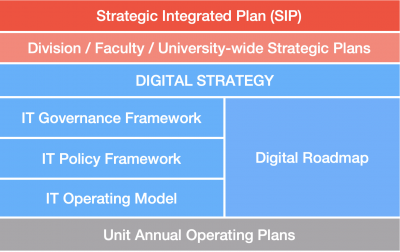In 2020, the Board of Governor’s Audit & Risk Committee commissioned PwC to audit Distributed Computing across Carleton. PwC’s audit recommended improvements in:
- Digital Policies – Awareness and Application
- Digital Governance – Oversight and Monitoring
- Communication and Training
As a result, much work has been done to formalize and modernize Carleton’s Digital Strategic and Operating Framework.

What is the Digital Strategic and Operating Framework? Picture a hierarchical structure with Carleton’s soon-to-be unveiled Digital Strategy sitting at the top. Underneath that sit important documents such as the IT Governance Framework, the IT Policy Framework, the IT Operating Model, and the Digital Roadmap. All of these documents are informed by the Strategic Integrated Plan (SIP) and various divisional, faculty and university-wide strategic plans.
Digital Strategy Comes to Fruition
The first layer includes a brand-new strategy that ITS has played an important role in bringing together: the Digital Strategy. In an increasingly connected world, Carleton University has an opportunity to transform our digital practices and mindset, and our inaugural Digital Strategy is a roadmap for this transformation—one guided by intention, responsibility, and innovation.
Developed in consultation with the entire community, the Digital Strategy is not a strategy for ITS. It’s a strategy for all things digital at Carleton. It will help us successfully implement the SIP, notably towards seizing opportunities to strengthen the student experience, enhancing our teaching and learning practices, building critical research capacities and modernizing our operations. The Digital Strategy is in its final production stages now and will be published and available to the community within the coming months.
IT Governance Document Modernized
Underpinning the Digital Strategy is the Information Technology (IT) governance framework. IT Governance at Carleton University Version 6.0 was approved in March 2022 by Carleton’s Information Systems Executive Committee (ISEC.) The document affirms that IT governance is a key requirement that greatly enhances the success of an organization.
To be effective, IT governance must help the university must make relevant and timely decisions, creating and stimulating the critical dialogue that will lead to better and more informed decisions, increasing transparency and the level of collaboration within the institution. IT governance at Carleton University is inclusive of teaching and learning, research, and administration. The scope of IT governance at Carleton University ensures that the investment in information technology aligns with the strategic direction, themes, and priorities of the university including the Strategic Integrated Plan.
IT Policy Framework in the Works
ITS is also rounding the corner on Carleton’s new IT Policy Framework. As part of its audit, PwC recommended the creation of a structure to organize policy documentation and provide overall direction. The current volume of IT-related policies, procedures, and guidelines at Carleton includes:
- 14 university policies
- 14 ITS policies
- Eight ITS procedures and guidelines
The purpose of this policy framework is to streamline the above policies, procedures, and guidelines. It will clearly define the policy instrument structure for IT at Carleton University and the boundaries within which all IT employed by, or on behalf of, the university must operate within. The policy framework will also separate procedure from policy, allowing more flexibility in addressing separate procedures for administrative, teaching and learning, and research uses of IT. The IT Policy Framework will be published and available to the community in fall 2022.
IT Operating Model Documents People, Processes, and Technology
As part of the above 2020 audit, PwC recommended the creation of an IT Operating Model to document how IT services at Carleton—people, processes, and technology—operate today.
Carleton currently operates under a distributed IT model, whereby units, departments, and faculties are empowered to individually select, deploy, and support digital services. Under this model, unit heads are accountable and responsible for digital services provided by their unit, department, or faculty.
The IT Operating Model, now in its consultation phase, identifies existing services and their corresponding accountabilities and expectations. It lays out the shared risks associated with operating IT services, as well as methods of understanding and managing that risk. It also delineates the accountabilities and responsibilities of operating IT services at Carleton.
High Level Technical Roadmap to Put Plans into Action
Recognizing that models, policies, frameworks, and strategies must be actualized to be successful, a Technical Roadmap will be published alongside the Digital Strategy to document the current fiscal year’s budgeted and committed digital initiatives. Focusing on digital process and regular renewal of Carleton’s digital direction, this roadmap will be kept current through an annual fall Information Systems Steering Committee (ISSC) digital planning and alignment session focusing on the following 12-18 months. To achieve a balanced portfolio of digital initiatives that align with the Digital Strategy’s principles and priorities, while supporting the direction of the SIP and helping Carleton make decisions about its digital future, the Digital Roadmap provides three focus areas: Strategic, Enterprise, and Organizational initiatives.
This story is a part of ITS’s Year in Review for 2021/22. Read more at our Year in Review homepage, or follow along on Twitter using the hashtag #ITSYearinReview. Thanks for reading!